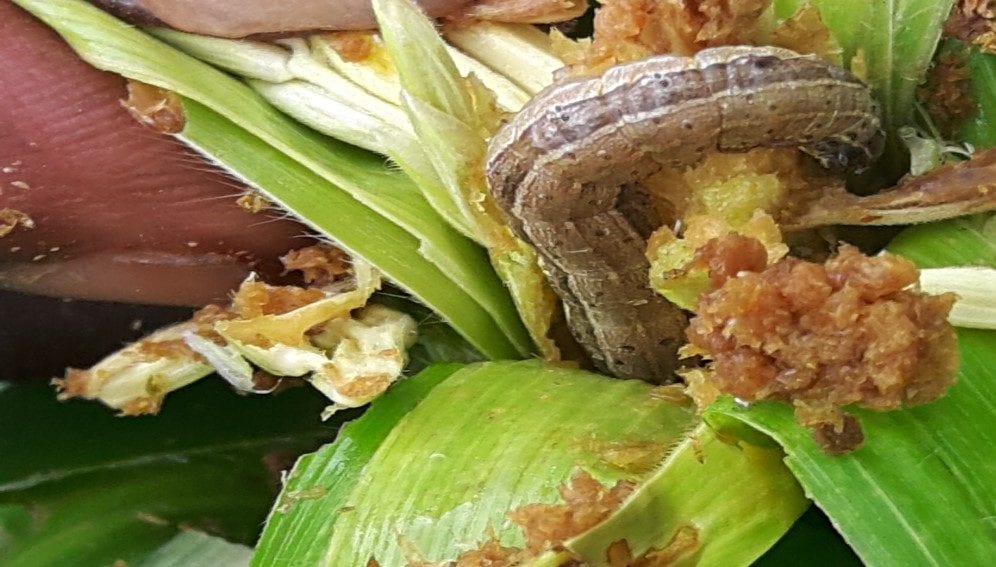Three natural enemies found to ‘beat fall armyworm’
SciDev,Net
26/3/2021

Speed read
- Fall armyworm causes Africa up to 18 million tonnes of maize losses a year
- Researchers have identified potential native insects to kill fall armyworm
- Cost-effectiveness of the approach needs to be determined, expert says
[NAIROBI] Maize farmers across Africa could soon find relief from the devastation caused by fall armyworm (FAW) following encouraging results from the use of indigenous natural enemies to fight the pest.
The UN Food and Agriculture Organization (FAO) estimates that fall armyworm causes Africa to lose up to 18 million tonnes of maize annually, representing an economic loss of as much as US$4.6 billion.
Researchers at the International Centre of Insect Physiology and Ecology (icipe) have identified three native parasitoids or insect species whose larvae live as parasites that eventually kill the hosts. The scientists saw promising results after mass releasing them into maize farms with fall armyworm in Kenya.
“The fact that the natural enemies are indigenous is advantageous as they will be adapted to the local environments.”
Lilian Gichuru, Alliance for a Green Revolution in Africa
“The initial post-release field assessments revealed that parasitism rates of FAW in the field increased by 55 per cent, 50 per cent and 38 per cent, for Trichogramma chilonis, Telenomus remus and Cotesia icipe, respectively,” says icipe, in a statement published last month. “The released parasitoids work synergistically to bring down the population of FAW by attacking different developmental stages (eggs and larvae) of the pest.”
According to the statement, during the last quarter of 2020, icipe researchers and national partners in Kenya began releasing 140,000 each of T. remus and T. chilonis wasps that parasitise FAW eggs and 5,000 C. icipe wasps that parasitise early larval stages of FAW. The field activities were conducted between December 2020 and February 2021 in five counties: Taita-Taveta, Machakos, Embu, Meru and Nyeri.
Sevgan Subramanian, principal scientist and leader of the environmental health theme at icipe, tells SciDev.Net that following the encouraging field experiment in Kenya, they are planning for mass production and release of the parasitoids in other African countries.
“Effectively conserving efficient indigenous natural enemies in the agroecosystem are among the better options for the management of a pest, as they are already adapted to survive in the prevailing ecological conditions and effectively control the pest,” Subramanian says.
But Subramanian adds that a key constraint is the lack of technical capacity for replication of natural enemy production facility in various countries.
The caterpillars of fall armyworms feed on the leaves, stems and reproductive parts of more than 100 plant species such as maize, rice, sorghum and sugarcane, as well as other crops, including cabbage, beet, peanut and soybean, pasture grasses and millet, causing major damage to cultivated plants.
The current FAW control methods based on the use of synthetic pesticides is detrimental to conservation of indigenous natural enemies, and has negative health effect for famers, consumers and the environment, he tells SciDev.Net.
He urges maize farmers and agricultural policymakers to adopt sustainable FAW management strategies such as promotion of diversified maize cropping systems.
Roger Day, programme executive for Action on Invasives at the Centre for Agriculture and Biosciences International (CABI, the parent organisation of SciDev.Net), says that a key issue is how many parasitoids need to be released to control the pest population.
“For instance, in trials in Brazil, there are reports of releasing 100,000-200,000 insects per hectare. So, the work reported by icipe appears to be small-scale or pilot releases. This is an important first step,” he adds.
Mass rearing, distributing and releasing parasitoids at the right time, Day explains, is not as easy as distributing pesticides, and it can be costly. If the cost of control is more than the value of the reduced crop loss, it is not worth doing it.
He also adds that it is still far from clear whether such mass releases can be cost-effective in Africa. And if three species of parasitoid are being released at once, that is likely to make the approach more expensive.
Lilian Gichuru, associate programme officer at the Alliance for a Green Revolution in Africa, welcomes the encouraging findings in Kenya.
“The fact that the natural enemies are indigenous is advantageous as they will be adapted to the local environments to thrive and multiply and naturally control FAW,” she says.
You might also like
- Smallholders get arsenals to fight fall armyworm
- Smallholders grappling with fall armyworm in Kenya
- Product could be solution to fall armyworm in Africa
- Global actions needed to combat fall armyworm
- Garlic, chillies among natural fall armyworm measures
- Biological weapon against fall armyworm found in Africa
- Action plan developed to tackle fall armyworm in Africa
Gichuru calls for programmes to educate farming communities on these non-chemical control options as part of pest control activities, and show farmers that although natural enemies do not offer quick “killing-effect”, they can suppress pest populations to manageable levels.
This piece was produced by SciDev.Net’s Sub-Saharan Africa English desk.
